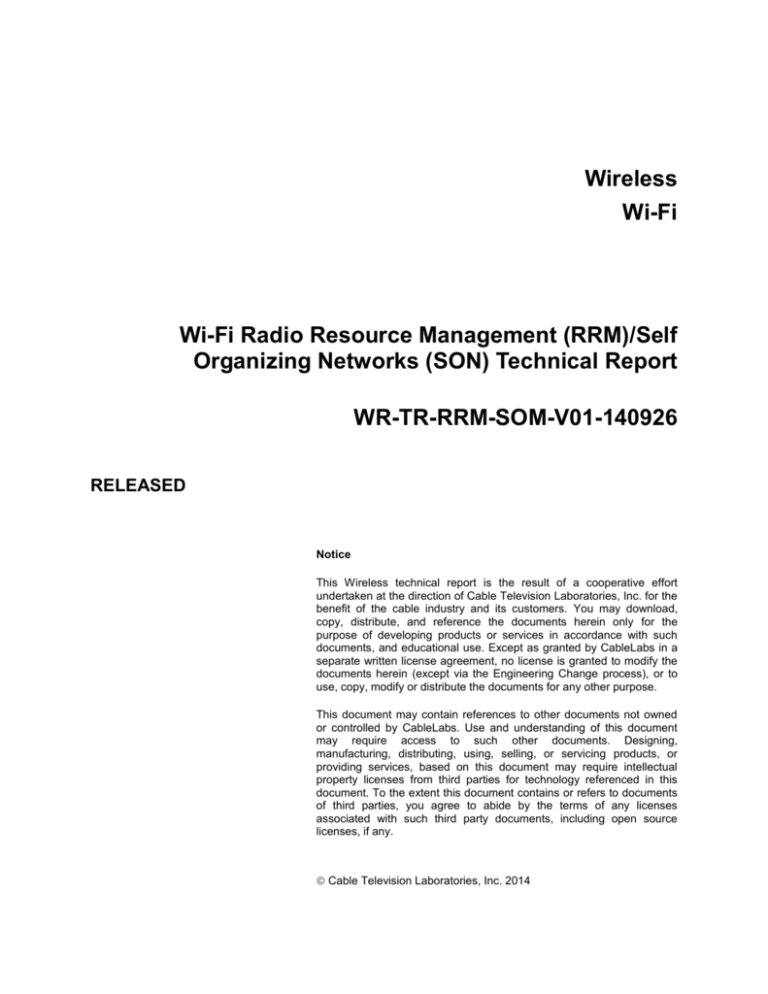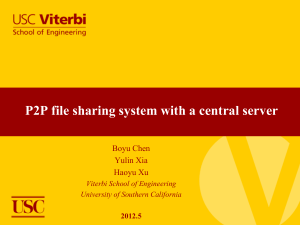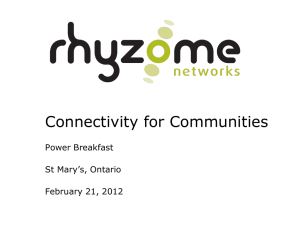- CableLabs
advertisement

Wireless Wi-Fi Wi-Fi Radio Resource Management (RRM)/Self Organizing Networks (SON) Technical Report WR-TR-RRM-SOM-V01-140926 RELEASED Notice This Wireless technical report is the result of a cooperative effort undertaken at the direction of Cable Television Laboratories, Inc. for the benefit of the cable industry and its customers. You may download, copy, distribute, and reference the documents herein only for the purpose of developing products or services in accordance with such documents, and educational use. Except as granted by CableLabs in a separate written license agreement, no license is granted to modify the documents herein (except via the Engineering Change process), or to use, copy, modify or distribute the documents for any other purpose. This document may contain references to other documents not owned or controlled by CableLabs. Use and understanding of this document may require access to such other documents. Designing, manufacturing, distributing, using, selling, or servicing products, or providing services, based on this document may require intellectual property licenses from third parties for technology referenced in this document. To the extent this document contains or refers to documents of third parties, you agree to abide by the terms of any licenses associated with such third party documents, including open source licenses, if any. Cable Television Laboratories, Inc. 2014 WR-TR-RRM-SOM-V01-140926 Wi-Fi Document Status Sheet Document Control Number: Document Title: Revision History: Date: Status: Distribution Restrictions: WR-TR-RRM-SOM-V01-140926 Wi-Fi Radio Resource Management (RRM)/Self Organizing Networks (SON) Technical Report V01 – 09/26/14 September 26, 2014 Work in Progress Draft Released Closed Author Only CL/Member CL/ Member/ Vendor Public Trademarks CableLabs® is a registered trademark of Cable Television Laboratories, Inc. Other CableLabs marks are listed at http://www.cablelabs.com/certqual/trademarks. All other marks are the property of their respective owners. 2 CableLabs 09/26/14 Wi-Fi Radio Resource Management (RRM)/Self Organizing Networks (SON) Technical Report WR-TR-RRM-SOM-V01-140926 DISCLAIMER This document is furnished on an "AS IS" basis and neither CableLabs nor its members provides any representation or warranty, express or implied, regarding the accuracy, completeness, noninfringement, or fitness for a particular purpose of this document, or any document referenced herein. Any use or reliance on the information or opinion in this document is at the risk of the user, and CableLabs and its members shall not be liable for any damage or injury incurred by any person arising out of the completeness, accuracy, or utility of any information or opinion contained in the document. CableLabs reserves the right to revise this document for any reason including, but not limited to, changes in laws, regulations, or standards promulgated by various entities, technology advances, or changes in equipment design, manufacturing techniques, or operating procedures described, or referred to, herein. This document is not to be construed to suggest that any company modify or change any of its products or procedures, nor does this document represent a commitment by CableLabs or any of its members to purchase any product whether or not it meets the characteristics described in the document. Unless granted in a separate written agreement from CableLabs, nothing contained herein shall be construed to confer any license or right to any intellectual property. This document is not to be construed as an endorsement of any product or company or as the adoption or promulgation of any guidelines, standards, or recommendations. 09/26/14 CableLabs 3 WR-TR-RRM-SOM-V01-140926 Wi-Fi Contents 1 OBJECTIVE ........................................................................................................................................................5 2 SCOPE ..................................................................................................................................................................6 3 INFORMATIVE REFERENCES ......................................................................................................................7 3.1 Reference Acquisition....................................................................................................................................7 4 ABBREVIATIONS AND ACRONYMS ............................................................................................................8 5 MARKET DRIVERS FOR RRM/SON .............................................................................................................9 6 CABLELABS’ CONTRIBUTIONS TO RRM/SON ...................................................................................... 10 6.1 Concept of Operations for RRM SON ......................................................................................................... 10 6.2 Status of the specifications .......................................................................................................................... 10 6.2.1 WBA’s Carrier Wi-Fi Guidelines......................................................................................................... 11 6.2.2 CableLabs’ Wi-Fi GW MGMT specification ....................................................................................... 11 7 RRM/SON ARCHITECTURE AND INTERFACES ..................................................................................... 12 8 RECOMMENDED FUTURE WORK ............................................................................................................. 14 Figures Figure 1 - RRM/SON Architecture Diagram ............................................................................................................... 13 4 CableLabs 09/26/14 Wi-Fi Radio Resource Management (RRM)/Self Organizing Networks (SON) Technical Report WR-TR-RRM-SOM-V01-140926 1 OBJECTIVE The primary goal of Wi-Fi Radio Resource Management (RRM)/Self Organizing Networks (SON) is to provide efficient operator managed and vendor interoperable Wi-Fi radio performance in the presence of large and dynamically changing numbers of APs and heavy user traffic. This report describes a strategy of leveraging a Wi-Fi SON server in the cloud/network that updates AP RF configurations based upon changes in local user traffic or networks topologies to help improve throughput and the user experience. The primary use case for RRM with SON is in MDUs where a significant portion of APs are managed by the MSO, although other use cases may apply. The Wi-Fi SON server is capable of running RRM algorithms which gets the inputs in the form of read parameters from the network and which gives out write parameters as outputs into the network. Additionally, a Wi-Fi SON server does the following: Optimizes network performance by modifying the RF parameters. Maintains a real time database of the RF parameters, which will be used as inputs to the SON algorithms. Manages coverage and interference including multi-band selection for better traffic load balancing. Leverages SON (Self Organizing Networks) concepts and [802.11k] protocol for better RRM in massive and congested network deployments. Addresses the dense indoor/residential deployment problems wherein low-cost Cable Wi-Fi deployments consist of non-intelligent standalone APs. RRM/SON allows the operators to manage the radio environment among various vendor solutions, or even unify RRM approach among certain AP vendors. 09/26/14 CableLabs 5 WR-TR-RRM-SOM-V01-140926 Wi-Fi 2 SCOPE The challenge to Wi-Fi operators to provide a satisfactory subscriber experience with the promised throughput rates is increasing, given the proliferation of Wi-Fi APs and devices with growing subscriber traffic demand. Operators are considering more effective radio resource techniques in order to help manage a satisfying user experience. RRM becomes very important, particularly in dense residential deployments where vendor interoperability is an issue. This report addresses the advantages of using a centralized SON server in the operator network and the work that CableLabs has done in this domain to help improve RRM. In the process, this report also addresses the possible network architectures in the presence of a SON server and how [802.11k] can be part of an overall Wi-Fi radio resource management strategy. 6 CableLabs 09/26/14 Wi-Fi Radio Resource Management (RRM)/Self Organizing Networks (SON) Technical Report WR-TR-RRM-SOM-V01-140926 3 INFORMATIVE REFERENCES This technical report uses the following informative references. References are either specific (identified by date of publication, edition number, version number, etc.) or non-specific. For a non-specific reference, the latest version applies. [3GPP SON] 3GPP Self-Organizing Networks, http://www.3gpp.org/technologies/keywords-acronyms/105son. [802.11] IEEE Std 802.11-2012, IEEE Standard for Information technology--Telecommunications and information exchange between systems Local and metropolitan area networks--Specific requirements Part 11: Wireless LAN Medium Access Control (MAC) and Physical Layer (PHY) Specifications. [802.11k] IEEE Std 802.11k-2008. IEEE Standard for Information technology- Local and metropolitan area networks-- Specific requirements-- Part 11: Wireless LAN Medium Access Control (MAC)and Physical Layer (PHY) Specifications Amendment 1: Radio Resource Measurement of Wireless LANs. [Voice over Wi-Fi Wi-Fi CERTIFIED™ Voice-Enterprise: Voice quality and bandwidth management tools for the enterprise, http://www.wi-fi.org/discover-wi-fi/wi-fi-certified-voice-programs [WBA Carrier Guidelines] WBA Carrier Guidelines, http://www.wballiance.com/resource-center/wba-white-papers/ [WBA Carrier WiFi] Carrier Guidelines, http://www.wballiance.com/wba/wpcontent/uploads/downloads/2014/03/WBA-Carrier-Wi-Fi-Guidelines-v1.0.pdf [WiFi-GW] Wi-Fi Requirements for Cable Modem Gateways, WR-SP-WiFi-GW, http://www.cablelabs.com/specs/specification-search/ Wi-Fi Roaming Architecture and Interfaces, WR-SP-WiFi-ROAM, Specification, http://www.cablelabs.com/wp-content/uploads/specdocs/ [WiFi-ROAM] [WR-SP-WiFiMGMT] 3.1 Wi-Fi Provisioning Framework Specification, WR-SP-WiFi-MGMT, http://www.cablelabs.com/specs/specification-search/ Reference Acquisition 3rd Generation Partnership Project, (3GPP), http://www.3gpp.org/ Cable Television Laboratories, Inc., 858 Coal Creek Circle, Louisville, CO 80027; Phone +1-303-661-9100; Fax +1-303-661-9199; http://www.cablelabs.com Internet Engineering Task Force (IETF) Secretariat, 46000 Center Oak Plaza, Sterling, VA 20166, Phone +1571-434-3500, Fax +1-571-434-3535, http://www.ietf.org Wi-Fi Alliance (WFA), http://www.wi-fi.org/ Wireless Broadband Alliance (WBA), http://www.wballiance.com/ 09/26/14 CableLabs 7 WR-TR-RRM-SOM-V01-140926 Wi-Fi 4 ABBREVIATIONS AND ACRONYMS This document uses the following abbreviations: ACS Auto Configuration Server AP Access Point BSSID Basic Service Set Identifier CM Cable Modem CMTS Cable Modem Termination System CWLAN DOCSIS ® Carrier Wi-Fi LAN Data-Over-Cable Service Interface Specifications LTE Long Term Evolution MAC Media Access Control MCS Modulation and Coding Scheme MDU Multi-Dwelling Unit MIMO Multiple-input multiple-output NBI North Bound Interface NPD National Product Development Research Group POC Proof Of Concept RF Radio Frequency RRM Radio Resource Management SBI South Bound Interface SSID Service Set Identifier SON Self Organizing Network STA Station VoD Video on Demand WFA Wi-Fi Alliance Wi-Fi Wireless Fidelity Wi-Fi AP Wi-Fi Fidelity Access Point Wi-Fi GW Wi-Fi Gateway WLC Wireless LAN Controller 8 CableLabs 09/26/14 Wi-Fi Radio Resource Management (RRM)/Self Organizing Networks (SON) Technical Report WR-TR-RRM-SOM-V01-140926 5 MARKET DRIVERS FOR RRM/SON With the advent of multiple mobile devices, every house has at least 5.7 devices according to a study by the NPD Group1. Wireless data usage is expanding at an exponential rate and will only continue to increase in years to come. Due to this, there is an onus on the operators to provide high throughput, low-latency services to their customers thereby supporting high bandwidth applications in home. A number of applications and services like Internet browsing, Video on Demand (VoD), interactive programming, 3D gaming, location based services etc. are being offered to the customers as a part of the cable services. On the access side, networks are becoming more and more complex and with the advent of new technologies, traffic offload and inter-networking is becoming more and more common. It is therefore incumbent on the operators to not only manage their access networks successfully but to also provide the necessary bandwidth and speeds to support the above mentioned applications and services in home. This calls for a significant improvement in the traditional radio network planning and network management for managing the growing traffic volumes and network complexities in a cost effective manner. Additionally, there is a need to manage certain functionalities of the network elements automatically. [3GPP SON] defines SON as a technology to configure network elements, optimize performance and to provide self-healing capabilities incase of network interference or faulty network elements. SON is a well-established concept in the world of LTE. Infonetics Research released excerpts from its 2013 SON and Optimization Strategies: Global Service Provider Survey2, for which Infonetics interviewed wireless, incumbent, and competitive operators around the world about their network optimization strategies and self-organizing network (SON) deployment plans. 87% of the operators who responded to the survey have deployed SON in their networks. The proliferation of SON in LTE networks suggests that larger operator-managed Wi-Fi networks could also take advantage of self organizing techniques. 1 The NPD Group, http://thenextweb.com/insider/2013/03/18/npd-us-homes-now-hold-over-500m-internet-connected-deviceswith-apps-at-an-average-of-5-7-per-household/ 2 Weissberger, Alan, 2013: Infonetics: 87% of Mobile Operators have Deployed Self Organizing Networks, found at http://community.comsoc.org/blogs/alanweissberger/infonetics-87-mobile-operators-have-deployed-self-organizing-networks 09/26/14 CableLabs 9 WR-TR-RRM-SOM-V01-140926 Wi-Fi 6 CABLELABS’ CONTRIBUTIONS TO RRM/SON A number of cable MSOs is interested in Wi-Fi RRM/SON to optimize network performance in dense residential deployments. CableLabs formed an RRM/SON vendor focus team consisting of both MSOs and vendors to help address the dense deployment problem. The focus team was instrumental in converging on and defining a set of read, write parameters, which govern the RRM/SON interface from the SON server. CableLabs has also defined RRM/SON use cases, based on which the SON algorithms could be triggered in the SON server. Section 7 explains the architectures in detail. Additionally, CableLabs was involved in leading this effort with a tier one Asian mobile operator in WBA. 6.1 Concept of Operations for RRM SON The primary goal of Wi-Fi SON is to ensure the best network performance to the user by addressing first order changes in the network environment. Another primary goal is for SON to be automated so that operational burden is reduced. More specifically, a few essential radio interface management parameters are updated when the SON server detects: Changes in network topology, for example the addition or removal of an operator AP Changes in the local environment, for example when operator APs see other Wi-Fi networks emerge or disappear Changes in interference conditions Changes in traffic patterns that effect the status of congestion hotspots With these changes in the environment are detected, the SON server can update the RF management parameters on the APs under its control in order to improve throughput to subscriber devices. For example, when operator managed APs are added the transmit power of certain other operator APs may be lowered to reduce interference. As another example, the carrier sense threshold of certain APs may be adjusted based on changes in interference conditions. The SON server does not attempt to response to localized actions by clients of APs that need to be dealt with in msecs by a local AP. Rather, the SON server takes a network wide view of first order conditions that can be responded to periodically to improve overall network performance in the longer term. Typical operational use of the SON server would be for the SON server to poll relevant information from the network APs over a time span of several days or a week. When the total set of information is available from a collation of APs for a given area of interest, the SON server may update the RF parameters for specific APs. Therefore, any given AP may need to provide information to the SON server only once a week, and see configuration updates only occasionally. This approach helps reduce the overhead of Wi-Fi SON functions. It also reduces the operational staff hours required to manage the network since the SON server management functions of the APs are automated. Studies, prototype tests, and a 30,000 AP operational Wi-Fi SON managed network in Asia all show substantial increases in throughput (50% or more) using this SON concept of operations. An essential component for SON operations is support for standardized and open interfaces between the SON server the APs. The algorithms used for the SON server to adjust the AP RF parameters, however, are intended to remain vendor or operator proprietary in order to encourage continued innovation. 6.2 Status of the specifications One of the major goals and achievements of the RRM/SON effort was to update the industry specifications. RRM/SON is now a part of the WBA’s Carrier Wi-Fi Guidelines and the CableLabs Wi-Fi Gateway Management specification. 10 CableLabs 09/26/14 Wi-Fi Radio Resource Management (RRM)/Self Organizing Networks (SON) Technical Report WR-TR-RRM-SOM-V01-140926 6.2.1 WBA’s Carrier Wi-Fi Guidelines As per [WBA Carrier Guidelines] Carrier Wi-Fi LAN (CWLAN) is defined as the carrier operated public Wi-Fi network, which is different from the consumer and enterprise networks meaning operators will have the means to manage radio resources, including the ability to, but not limited to, manage the following list of parameters below. The CWLAN will provide means to manage these parameters through standardized interfaces. Transmit power MCS rates MIMO and MU-MIMO configurations Beam forming configurations Channel bandwidth Maximum throughput per device Carrier sense thresholds Multi Band configuration and steering of devices, which can include dynamic traffic load sharing across bands Subscriber and service-driven dynamic load balancing among APs, bands and channels Channel assignments Interference avoidance and mitigation for higher density deployments The CWLAN will support the operator’s ability to collect and monitor the KPIs listed below. (Note that KPI value ranges may need to be targeted to certain services): Received signal strength from devices Noise and interference levels Packet error rates and packet loss rates Throughput of uplink and downlink per device Device location Load threshold indicators Channel utilization Band utilization Rogue AP detection Neighbor AP detection Delays, latencies and jitter for traffic uplink and downlink 6.2.2 CableLabs’ Wi-Fi GW MGMT specification The [WR-SP-WiFi-MGMT] specification gives the management requirements for the Wi-Fi air interface and roaming as defined in the [WiFi-GW] and [WiFi-ROAM] specifications respectively. This specification states that the Wi-Fi GW should be able to report RRM related parameters (called read parameters) to the Wi-Fi SON controller and should allow RRM related parameters to be set by the SON controller (called write parameters). These parameters are defined in Section 8 of this document. 09/26/14 CableLabs 11 WR-TR-RRM-SOM-V01-140926 Wi-Fi 7 RRM/SON ARCHITECTURE AND INTERFACES The Wi-Fi SON server can be cloud/network based which will interface with different network elements depending on MSO requirements and architecture. Figure 1 below lists the possible interfaces from a Wi-Fi SON server. Interface 1: Wi-Fi SON serverACSWLCAPs Interface 2: Wi-Fi SON serverWLCAPs This option is for vendors whose WLCs interface directly with the SON server without an ACS. Interface 3: Wi-Fi SON serverACSAPs This option serves well for vendors with Wireless LAN Controllers and thin APs This option is for the standalone AP vendors. Interface 4: Wi-Fi SON server APs This option is for standalone AP vendors, which can directly interface with the SON server. For a Wi-Fi RRM/SON server to be able to interoperate with various vendor solutions, both the Wi-Fi GW and WLC must support TR-069/SNMP at its North Bound Interface (NBI). The interface between the SON server and an ACS can be a web services based one. A number of MSOs are looking at web services framework for this interface. The SON server should be able to support the standardized [802.11] protocols like 802.11k, 802.11v and 802.11r. All these protocols are currently a part of the WFA (WiFi Alliance) Voice Enterprise certification program. The interface between the WLC and the thin APs is vendor proprietary. We recommend using [802.11k] protocol for the interface between the AP and the STAs. 802.11k air interface features help devices make improved AP selection based on current radio and traffic conditions. With 802.11k, the WFA aims to support device transitions across APs within 50msec in the face of heavy traffic. 802.11k also provides a standardized MIB that reports key parameters to the network. Noise levels, received signal strength, the number clients being served, and other RF environment characteristics are available to the operator to help them understand and manage their Wi-Fi radio access network. But 802.11k does not offer a standardized MIB that supports the adjustment of AP settings for the operator to manage the air interface. Furthermore, 802.11k does not provide a means to steer clients through multiple bands or channels, which is an important element of radio resource management. Additional capabilities to control the APs are needed for the operator to adjust their RF environment based upon information available from 802.11k. In summary, 802.11k helps devices make better selection of APs and SSIDs based on the RF environment. It allows APs to report critical radio environment information to the Wi-Fi network operator. But 802.11k does not specify a standard AP configuration interface that can be used by operators cause APs to direct devices to bands or channels, or to manage AP RF settings, although these can be part of other standardized IEEE MIBs. Therefore, 802.11k can play an important part in reporting the RF environment to operators when combined with controller and AP management interface capabilities. 12 CableLabs 09/26/14 Wi-Fi Radio Resource Management (RRM)/Self Organizing Networks (SON) Technical Report WR-TR-RRM-SOM-V01-140926 Figure 1 - RRM/SON Architecture Diagram Each SON server will run its own proprietary SON algorithms, which are governed by the RRM/SON use cases. Load balancing, Neighbor list generation and optimization, QoS related parameter optimization, Coverage hole detection etc. are a few use cases. It is up to the discretion of an operator to define RRM/SON use cases. Each SON algorithm will take in a set of inputs (read parameters) and will produce a set of outputs (write parameters) into the network. These read and write parameters are a part of the UML diagram as well which can be seen in [WR-SP-WiFiMGMT]. 09/26/14 CableLabs 13 WR-TR-RRM-SOM-V01-140926 Wi-Fi 8 RECOMMENDED FUTURE WORK CableLabs is working with vendors to implement the RRM/SON parameters and support the various interfaces that are shown in this document. Once there is considerable vendor participation, CableLabs can host a Proof of Concept (PoC) interop for RRM/SON. Per MSO requests, CableLabs can address standardizing the RRM/SON interfaces since MSOs have different architectures for different kind of services. Also work can be done to standardize the mechanism for sharing the information with the clients because currently clients have their own proprietary way of reporting/receiving information from an AP/any other server. Additionally, CableLabs, MSOs and vendors may consider working together to enable web services at the South Bound Interface (SBI) of the SON server. 14 CableLabs 09/26/14







